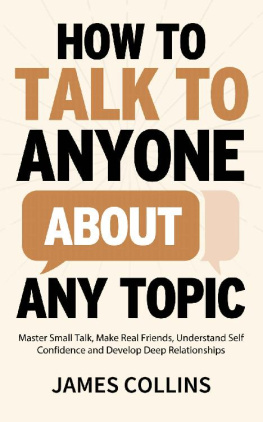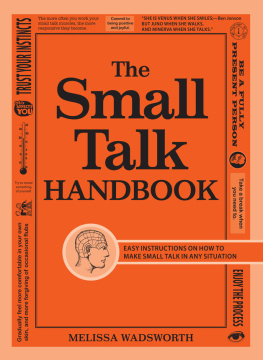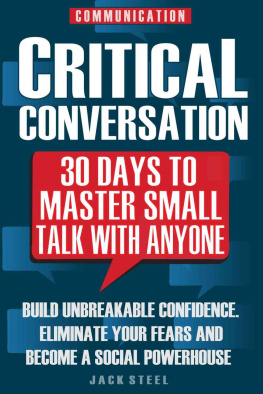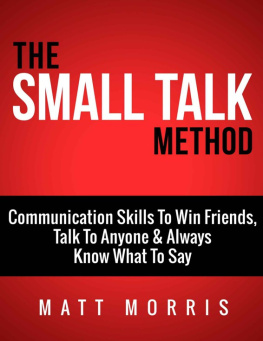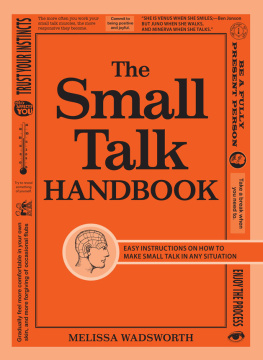Copyright 2019 by Rockridge Press, Emeryville, California
No part of this publication may be reproduced, stored in a retrieval system or transmitted in any form or by any means, electronic, mechanical, photocopying, recording, scanning or otherwise, except as permitted under Sections 107 or 108 of the 1976 United States Copyright Act, without the prior written permission of the Publisher. Requests to the Publisher for permission should be addressed to the Permissions Department, Rockridge Press, 6005 Shellmound Street, Suite 175, Emeryville, CA 94608.
Limit of Liability/Disclaimer of Warranty: The Publisher and the author make no representations or warranties with respect to the accuracy or completeness of the contents of this work and specifically disclaim all warranties, including without limitation warranties of fitness for a particular purpose. No warranty may be created or extended by sales or promotional materials. The advice and strategies contained herein may not be suitable for every situation. This work is sold with the understanding that the publisher is not engaged in rendering medical, legal, or other professional advice or services. If professional assistance is required, the services of a competent professional person should be sought. Neither the Publisher nor the author shall be liable for damages arising herefrom. The fact that an individual, organization or website is referred to in this work as a citation and/or potential source of further information does not mean that the author or the Publisher endorses the information the individual, organization or website may provide or recommendations they/it may make. Further, readers should be aware that Internet websites listed in this work may have changed or disappeared between when this work was written and when it is read.
For general information on our other products and services or to obtain technical support, please contact our Customer Care Department within the U.S. at (866) 744-2665, or outside the U.S. at (510) 253-0500.
Rockridge Press publishes its books in a variety of electronic and print formats. Some content that appears in print may not be available in electronic books, and vice versa.
TRADEMARKS: Rockridge Press and the Rockridge Press logo are trademarks or registered trademarks of Callisto Media Inc. and/or its affiliates, in the United States and other countries, and may not be used without written permission. All other trademarks are the property of their respective owners. Rockridge Press is not associated with any product or vendor mentioned in this book.
Designer: Antonio Valverde
Interior Designer: Lindsey Dekker
Photo Art Director/Art Manager: Michael Hardgrove
Editor: Emily Angell
Production Editor: Chris Gage
Illustration Diego Schtutman/Shutterstock.com, .
Interior art used under license from Shutterstock.com.
ISBN: Print 978-1-64152-895-5 | eBook 978-1-64152-896-2
R0
To Colleenmy favorite conversation partner for 46 years and counting.
CONTENTS

Welcome, and congratulations on taking your first step toward making small talk with other people a stress-free experience.
Casual conversation, or what is often referred to as small talk, is part of everyday life for the majority of us. Most of us have been talkingand listeningto each other since we were toddlers. For many people, conversations feel as natural as breathing. You speak. They respond. You in turn respond to their response. The words flow naturally and easily, like a properly struck tennis ball lobbed back and forth over a net.
Yet for others, engaging in small talk is a very different experience. It feels more like being placed on a stage, with the glare of a bright spotlight shining down and the audience waiting on every word. The omnipresent fear is that if they utter anything that is not completely correct, everyone will notice!
As a psychotherapist who specializes in treating anxiety disorders such as fears and phobias, I frequently encounter those who suffer from social anxiety disorder (SAD), or the fear of interacting with other people. A survey led by Dr. Ronald Kessler of Harvard has shown that more than 12 percent of people suffer from this fear over the course of a lifetime, and in some cases, it can be debilitating.
For some people, conversations are so painful and humiliating that they avoid them completely. In my therapy practice, I have treated people who could not go to work, attend school, or in one case, even step outside their house for fear of having to speak to someone. People who suffer from this issue are generally highly intelligent and, more often than you might think, reasonably articulatebut understandably, they worry about the social or emotional consequences of what they say to other people.
But then something magical happens when these same people learn the mechanics of how to make small talk. They are able to go back to class. They start dating. They can choose what they want to do without being as worried about whether other people will engage them. And in some cases, they discover that they have learned how to communicate much better than most people.
The foundational reason behind this is that learning to have a conversation is not quite the same as overcoming other types of fears. It is more similar to learning to play a piano: There are basic building blocks that, once understood, make it much easier to improvise. When an individual is taught the mechanics of how to greet people, ask good questions, provide meaningful self-disclosure, andmost importantacknowledge people so that they feel deeply heard, it replaces fear with confidence.
That is ultimately the point of this book: Small talk is a skill , just as learning how to bake a cake from a cookbook is a skill. There are clear phases to every conversation and teachable steps you can take to master each of these phases. If you learn and practice them, you will discover that you really can learn to be confident in any conversation.
This book will teach you how to make small talk in a way that you may not have seen before: as a series of reproducible steps that anyone can do. Combined with a strategy of gradual exposure and mindful awareness, based on principles of cognitive-behavioral therapy (CBT), losing the fear of conversation can be much easier than you might think.
Note that ongoing or debilitating social anxiety should be addressed by a medical professional. This book is not a solution for frequent feelings of high stress or anxiety in social situations, nor is it a replacement for a therapist, medication, or medical treatment, and there is no shame in reaching out for help. If you are currently under the care of a professional, consult with them for personalized advice for your situation, and feel free to show them this book to discuss the possibility of integrating its concepts into your treatment plan.





